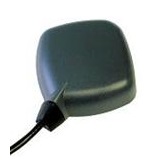- Home
- Symmetry Blog
- A Guide to the 5 Types of Cellular Antennas
A Guide to the 5 Types of Cellular Antennas
Wednesday, September 3, 2014
A Quick Review of Antennas: 101

An antenna is an electrical device which converts electric power into radio waves, and vice versa. It is usually used with a radio transmitter or radio receiver. In transmission, a radio transmitter supplies an oscillating radio frequency electric current to the antenna's terminals, and the antenna radiates the energy from the current as electromagnetic (radio) waves. In reception, an antenna intercepts some of the power of an electromagnetic wave in order to produce a tiny voltage at its terminals that is applied to a receiver to be amplified.
Antennas are essential components of all equipment that uses radio. They are used in systems such as radio broadcasting, broadcast television, two-way radio, communications receivers, radar, cell phones, and satellite communications, as well as other devices such as garage door openers, wireless microphones, Bluetooth-enabled devices, wireless computer networks, baby monitors, and RFID tags on merchandise.
Now that we have the boring technical jargon out of the way, let's get to the meat of the matter - "Which antenna do I need?” Let's examine the fundamentals and then take a look at some examples of two way radio antenna connections so you can easily determine what type of connector you currently have on your radio or what connector you need for your new purchase.
Cellular Antennas: Selecting the Right One is Critical to Success
Before we get started please remember one important thing: 99.9% of two way radio failure is due to either the antenna being improper (meaning it's not made for the frequency used), or the antenna not being properly tuned to accommodate the transmitting frequency. Your antenna is the most important part of your two way radio system; however, it is often the most overlooked component. Getting the antenna right is 100% critical to not only achieving good performance but also maintaining the life of your equipment. If you are a novice when it comes to two way radios and antennas, you would be wise to take a few minutes and read the material provided here. A few minutes of reading may save you money and a big headache in the future.
With regard to antennas, the basic rule of thumb is, the taller (or larger) the antenna is, the more decibel (dB) gain it produces. The more dB gain, the better the performance. Now there are exceptions to this rule, but only in some unique circumstances. If you want to reach out as far as possible with your two way radio, then you want the tallest antenna with the most dB gain you can afford or tolerate (as far as antenna height goes). You may want to take into consideration your garage at home for antenna height on your vehicle, not to mention the McDonalds drive-thru window. It's a give and take: taller antennas work better (in most cases), but it could possibly interfere with your busy lunch schedule when trying to navigate the fast food drive thru window.
5 Types of Cellular Antennas
1. Wideband 690-2700 MHz Log Periodic Antenna - 8-10dB Gain
A wideband log periodic antenna offers exceptional performance on all the major wireless carriers’ frequencies as well as GPS, Wi-Fi, and WiMax frequencies. Typically they have a low standing wave ratio (SWR) of less than 1.5:1 across the entire specified frequency range. Low SWR equates to maximum power being conducted from the antenna providing maximum signal range.
2. Wideband 800-2500 MHz Log Periodic Antenna - 10dB Gain
Designed for easy outside installation on a mast/pole, a wideband directional antenna is ideal for use outside homes, offices, and commercial buildings in areas of low cellular signal strength. This kind of antenna offers excellent signal pulling power for fixed installations where previously few solutions existed.
3. Multi-Band 698-1000 and 1700-2700 MHz Panel Antenna - 7-10dB Gain
Multi wideband antennas offers higher performance on all the major wireless carriers’ frequencies as well as Wi-Fi and WiMax frequencies.
4. Yagi 700 MHz 4G LTE Antenna - 6dB Gain
A quality Yagi antenna for the 700 MHz bands has applications that include 4G LTE, SMH bands, point to multipoint, and public safety. Some features include a wider beamwidth, 6dB gain, and a rugged powder coated finish to provide outstanding corrosion resistance and longevity in the harshest environments. Maximum performance and distance is achieved with a voltage standing wave ratio (VSWR) of less than 1.5:1 across the entire frequency band (650-830 MHz).
5. Wideband Yagi 880-960 MHz Antenna - 14dB Gain
A wideband Yagi similar to its LTE counterpart has a wide frequency range, higher gain, and a rugged powder coated finish. Applications include GSM 900, ISM, CMTS, and DSRR. This antenna has an excellent front to back ratio to block unwanted signals.
If you need help determining the correct antenna for your cellular application, please don't be afraid to ask us. After all, at Symmetry Electronics, wireless is our business! Call us at (310) 536-6190, or contact us online.